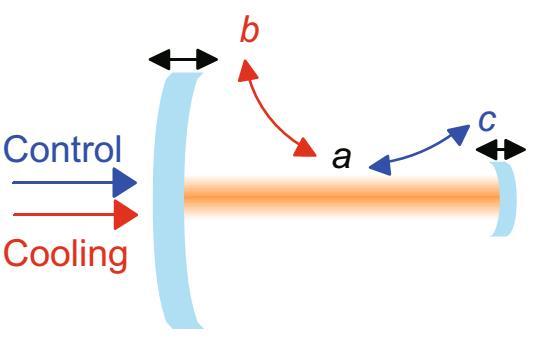Cooling massive objects to the quantum ground state

This image shows an optomechanical system with two mechanical modes coupled to the same optical mode. Credit: ©Science China Press
However, the cooling limit is subjected to the quantum backaction, and ground state cooling is possible only in the resolved sideband limit, which requires the resonance frequency of the mechanical motion to be larger than the cavity decay rate.
This sets a major obstacle for the ground state preparation and quantum manipulation of macroscopic and mesoscopic mechanical resonators, since more massive resonators typically have lower mechanical resonance frequencies. Therefore, it is essential to overcome this limitation, so that ground state cooling can be achieved for massive objects.
Very recently, Professor Yun-Feng Xiao and Ph.D student Yong-Chun Liu at Peking University, collaborated with Columbia University, have proposed an unresolved sideband ground-state cooling scheme in a generic optomechanical system, by taking advantage of the destructive quantum interference in a cavity optomechanical system with two mechanical modes coupled to the same optical cavity mode (Figure 1), where optomechanically-induced transparency phenomenon occurs.
They find that using the multiple inputs, the cascaded cooling effect further suppresses the quantum backaction heating. They show that ground state cooling of the mechanical mode beyond the resolved sideband limit by nearly three orders of magnitude can be achieved.
“This cooling approach adds little complexity to the existing optomechanical system, which is crucial in the experimental point of view.” said Yong-Chun Liu, the first author of the paper. Compared with the conventional backaction cooling approach, the additional requirement here is a control mechanical mode and one (or more) input laser.
It is experimentally feasible for various optomechanical systems within current technical conditions. On one hand, many optomechanical systems possess abundant mechanical modes with different resonance frequencies, since the oscillation have different types and orders.
This situation can be found in optomechanical systems using whispering-gallery microcavities, photonic crystal cavities, membranes, nanostrings and nanorods amongst others. On the other hand, composite optomechanical systems, containing two independent mechanical resonators, are also conceivable. For example, in Fabry-Perot cavities, the motion of one mirror acts as a control mechanical mode while the other mirror is to be cooled (Figure 1).
“This study paves the way for the manipulation of macroscopic mechanical resonators in the quantum regime.” said Yun-Feng Xiao.
###
This research was funded by the National Basic Research Program of China (Grant Nos. 2013CB328704 and 2013CB921904), the National Natural Science Foundation of China (Grant Nos. 11474011, 11222440 and 61435001), the Research Fund for the Doctoral Program of Higher Education of China (Grant No. 20120001110068) and the Optical Radiation Cooling and Heating in Integrated Devices Program of Defense Advanced Research Projects Agency (Grant No. C11L10831).
See the article:
Yong-Chun Liu, Yun-Feng Xiao, Xingsheng Luan, and Chee Wei Wong, Optomechanically-induced-transparency cooling of massive mechanical resonators to the quantum ground state. Sci China-Phys Mech Astron, 2015, 58: 050305, doi: 10.1007/s11433-014-5635-6
http://phys.
Media Contact
All latest news from the category: Physics and Astronomy
This area deals with the fundamental laws and building blocks of nature and how they interact, the properties and the behavior of matter, and research into space and time and their structures.
innovations-report provides in-depth reports and articles on subjects such as astrophysics, laser technologies, nuclear, quantum, particle and solid-state physics, nanotechnologies, planetary research and findings (Mars, Venus) and developments related to the Hubble Telescope.
Newest articles

NASA: Mystery of life’s handedness deepens
The mystery of why life uses molecules with specific orientations has deepened with a NASA-funded discovery that RNA — a key molecule thought to have potentially held the instructions for…

What are the effects of historic lithium mining on water quality?
Study reveals low levels of common contaminants but high levels of other elements in waters associated with an abandoned lithium mine. Lithium ore and mining waste from a historic lithium…

Quantum-inspired design boosts efficiency of heat-to-electricity conversion
Rice engineers take unconventional route to improving thermophotovoltaic systems. Researchers at Rice University have found a new way to improve a key element of thermophotovoltaic (TPV) systems, which convert heat…



